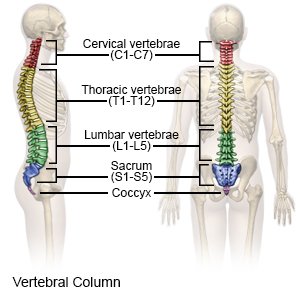Vertebroplasty
Medically reviewed by Drugs.com. Last updated on Aug 4, 2025.
WHAT YOU NEED TO KNOW:
Vertebroplasty is a procedure to fix broken vertebrae.
 |
HOW TO PREPARE:
The week before your procedure:
- Arrange to have someone drive you home when you are discharged.
- Tell your healthcare provider about all medicines you currently take. He or she will tell you if you need to stop any medicine for the procedure, and when to stop. He or she will tell you which medicines to take or not take on the day of the procedure.
- You may need a spinal x-ray, CT scan, MRI, or a bone scan. You also may need blood tests before your procedure.
The night before your procedure:
You may be told not to eat or drink anything after midnight.
The day of your procedure:
- You or a close family member will be asked to sign a legal document called a consent form. It gives healthcare providers permission to do the procedure or surgery. It also explains the problems that may happen, and your choices. Make sure all your questions are answered before you sign this form.
- Take only the medicines your healthcare provider told you to take.
- An IV will be placed into a vein. You may be given liquids or medicine through the IV.
- An anesthesiologist will talk to you before your surgery. You may need medicine to keep you asleep or numb an area of your body during surgery. Tell healthcare providers if you or anyone in your family has had a problem with anesthesia in the past.
WHAT WILL HAPPEN:
What will happen:
- A small incision will be made over your broken vertebrae where a needle will be inserted. Your healthcare provider may insert the needle directly into your skin to reach your broken vertebrae. Cement is then injected through the needle into your vertebrae to fill the broken or cracked area. After the cement is injected, the needle is removed.
- If an incision was made in your back, it will be closed with stitches. A bandage may be placed over the area where your procedure was done. Your healthcare provider may do an x-ray or CT scan to check for any leaks.
After your procedure:
You will be taken to a room to rest until you are fully awake. You will lie flat until the cement fully hardens. Healthcare providers will monitor you closely for any problems. Do not get out of bed until your healthcare provider says it is okay. When your healthcare provider sees that you are okay, you will be taken to your hospital room.
CONTACT YOUR HEALTHCARE PROVIDER IF:
- You have a fever.
- You get a cold or the flu.
- You have worsening pain that travels to your legs.
- You have increased trouble walking or moving around.
- You have questions or concerns about your procedure.
Seek Care Immediately if
- You are not able to move one or both of your legs.
- You have pain in your rib area or lower back.
- You have sudden shortness of breath or chest pain.
Risks
Your nerves and spinal cord may be damaged during the procedure. Spinal cord damage may cause you to leak spinal fluid, and you may become paralyzed. Nearby vertebrae or bones, such as the ribs, may get fractured. After your procedure, you may have bruising, increased pain, and you may get an infection. Cement may leak into your spinal cord, kidneys, and blood vessels. You may develop a life-threatening blood clot.
Related medications
Care Agreement
You have the right to help plan your care. Learn about your health condition and how it may be treated. Discuss treatment options with your healthcare providers to decide what care you want to receive. You always have the right to refuse treatment.© Copyright Merative 2025 Information is for End User's use only and may not be sold, redistributed or otherwise used for commercial purposes.
The above information is an educational aid only. It is not intended as medical advice for individual conditions or treatments. Talk to your doctor, nurse or pharmacist before following any medical regimen to see if it is safe and effective for you.
Further information
Always consult your healthcare provider to ensure the information displayed on this page applies to your personal circumstances.
